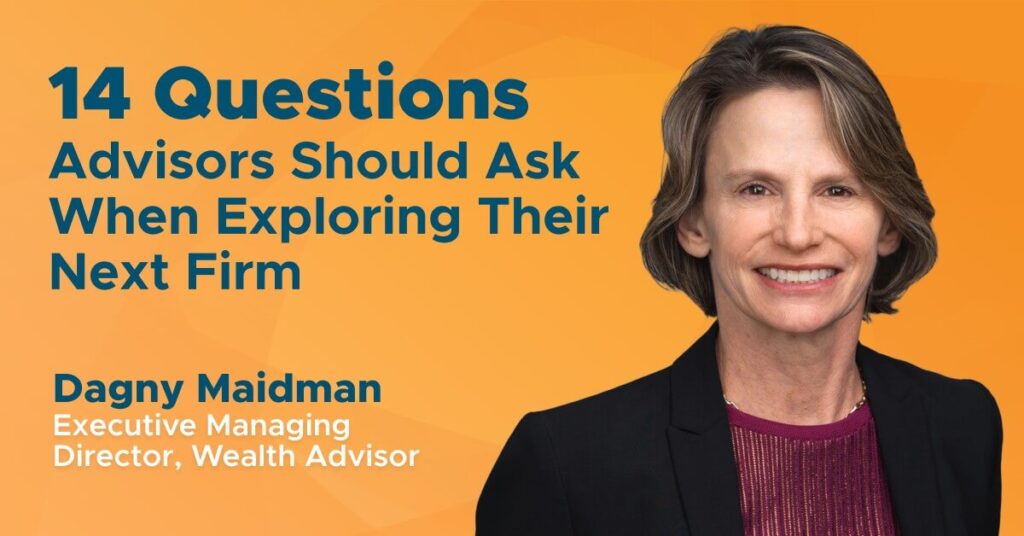
By Dagny Maidman, Executive Managing Director, Wealth Advisor at Cresset
If you are considering a move, you are not alone. Between 2012 and 2022, the four major wirehouses experienced a 10% decrease in advisor headcount, while the RIA sector grew its advisor base by 66%. The trend toward independence is accelerating.
After nearly 30 years in business, with a team of nine dedicated colleagues, more than $3.5 billion in assets under management, and serving more than 45 households (with an average tenure of 10 years), my team and I faced a pivotal decision: finding the right firm for the next stage of our careers.
We approached this decision with extreme care to help ensure we found a platform that offered the breadth of services, autonomy, and true fiduciary standards essential for our team, our clients, and our business to thrive.
For those contemplating their next step, I’m sharing the key questions that guided our process — and what we found most important as we evaluated each opportunity:
Client Offering and Platform Strength
- What products and services do my clients need so we can thrive at another firm and attract new clients?
Aim to prioritize platforms offering true flexibility across investments, planning, banking, and alternatives — without proprietary product constraints. - If the firm makes a big deal about offering great products, ask for performance metrics — don’t just believe the story.
Marketing claims are easy to make; insist on real, verifiable performance data to evaluate the firm’s investment capabilities and product quality.
Economics, Ownership, and Equity
- How does compensation work at the new firm and how does “the deal” work? Does the equity pay a dividend?
Beyond the headline numbers, understand net after-tax economics, equity upside potential, whether the firm’s equity pays a dividend, and whether compensation truly aligns advisor and client interests. - What is the capital structure of the company, and in particular, what is the debt load?
Understand who owns the firm, how it’s capitalized, what debt it carries, and how aligned major stakeholders are with long-term advisor success. Ask whether owners pay themselves market compensation or artificially inflate EBITDA to enhance perceived valuation.
Leadership, Growth, and Stability
- Do I trust the firm has the right leadership in place to move things to the next level?
Compounding equity may only make sense if you believe in the leadership team, strategy, operations, and business development infrastructure. - What is the reputation of the firm’s leaders and brand in the market?
Evaluate leadership integrity, governance structures, and external reputation to assess long-term stability. - What is the growth rate and retention rate of the advisors the firm has onboarded?
Historical advisor growth and retention rates are important indicators of future advisor satisfaction and cultural fit.
Growth Acceleration and Resources
- Will I be able to grow my business faster on the new platform (and not have client attrition)?
Assess marketing support, client onboarding experience, brand reputation, and technology stack — these are real drivers of post-transition success. - Does the firm have experts and resources I can leverage to grow and retain my client base?
Access to in-house specialists in investments, planning, tax, estate, and private banking can dramatically expand your client offering and support accelerated growth.
Culture, Vision, and Advisor Influence
- Will the new platform have a culture that is attractive to my team and aligned with our values?
Culture is critical for talent retention. Look for an environment that values collaboration, rewards growth, embraces innovation, and invests in professional development. - How adaptable and willing to change is the firm you are considering?
Choose a firm that is nimble and proactive about evolving client expectations, technology innovation, and regulatory shifts. - Will my voice be heard?
Firms that genuinely incorporate advisor feedback into decision-making tend to create stronger advisor communities and better client outcomes.
Autonomy and Succession
- How much control/autonomy do advisors have over their books of business?
Ensure you will retain true client ownership, pricing flexibility, and open architecture access post-transition. - How does the firm support advisors in succession planning, continuity, and long-term career development?
Look for structures that help you plan for your own retirement, ensure client continuity, and offer your team clear pathways for future growth.
Final Thoughts
The right platform can meaningfully accelerate your growth, strengthen your client relationships, and expand your career opportunities. Asking hard questions — and expecting clear answers — is essential to making the best move for yourself, your team, and your clients.
If you’re beginning your own due diligence, I hope this framework is helpful as you evaluate your options.
Contact us to learn more.
[1] Source: John Chudzick, “From wirehouse to RIA: How financial advisors can navigate the transition, October 29, 2024, Hanover: https://www.hanoversearch.com/blog/from-wirehouse-to-ria-financial-advisors/”
This document does not constitute advice or a recommendation or offer to sell or a solicitation to deal in any security or financial product. It is provided for information purposes only and on the understanding that the recipient has sufficient knowledge and experience to be able to understand and make their own evaluation of the proposals and services described herein, any risks associated therewith and any related legal, tax, accounting or other material considerations. To the extent that the reader has any questions regarding the applicability of any specific issue discussed above to their specific portfolio or situation, prospective investors are encouraged to contact Cresset or consult with the professional advisor of their choosing.
Certain information contained herein has been obtained from third party sources and such information has not been independently verified by Cresset. No representation, warranty, or undertaking, expressed or implied, is given to the accuracy or completeness of such information by Cresset or any other person. While such sources are believed to be reliable, Cresset does not assume any responsibility for the accuracy or completeness of such information. Cresset does not undertake any obligation to update the information contained herein as of any future date.
Except where otherwise indicated, the information contained in this presentation is based on matters as they exist as of the date of preparation of such material and not as of the date of distribution or any future date. Recipients should not rely on this material in making any future investment decision.
About Cresset
Cresset is an independent, award-winning multi-family office and private investment firm with more than $235 billion in assets under management and advisement (as of 10/31/2025). Cresset serves the unique needs of entrepreneurs, CEO founders, wealth creators, executives, and partners, as well as high-net-worth and multi-generational families. Our goal is to deliver a new paradigm for wealth management, giving you time to pursue what matters to you most.
https://cressetcapital.com/disclosures/
